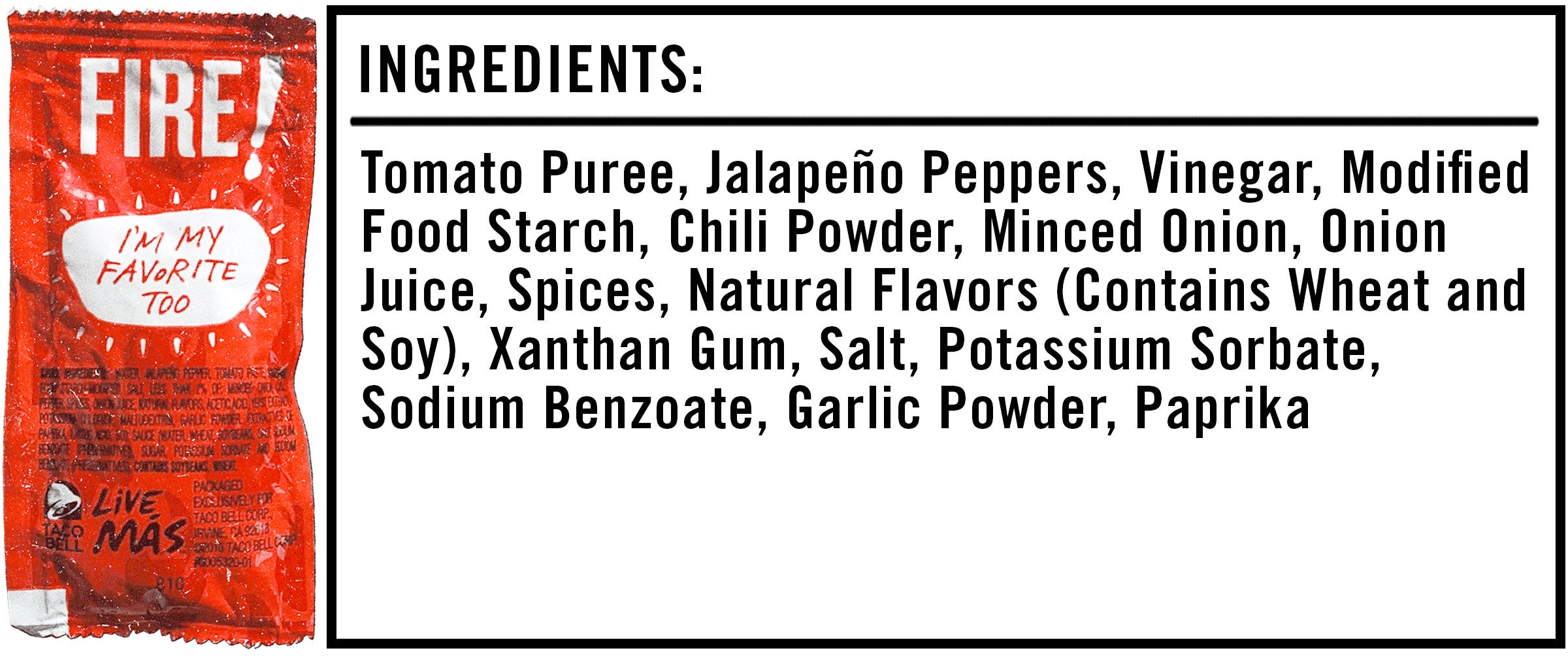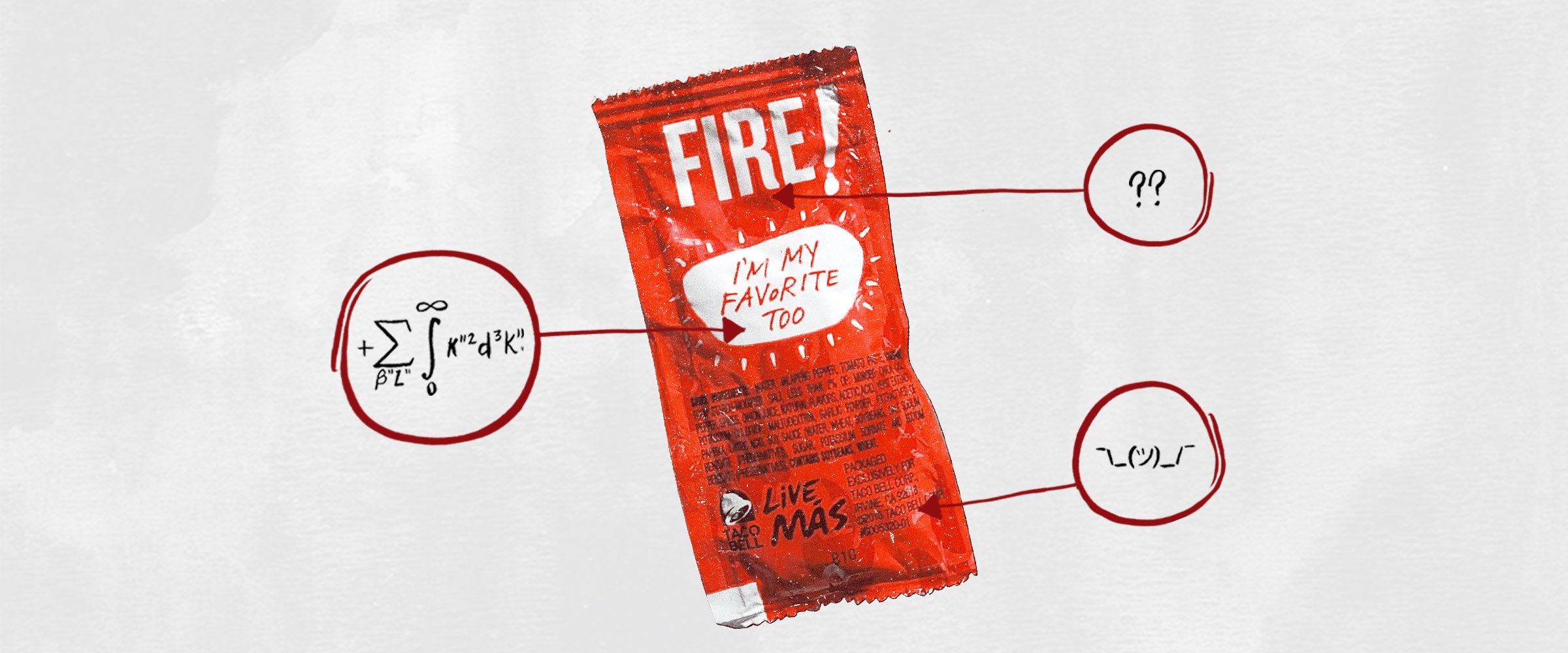We’re often told that you should never eat anything (or put anything on your body) if you don’t recognize everything on the ingredients list. But since most of us have no idea what xanthan gum or potassium benzoate are — or more importantly, what they’re doing to our bodies — we’re decoding the ingredients in the many things Americans put in (and on, or near) themselves.
This edition: Taco Bell Fire sauce, which is made from 15 separate ingredients that we’ve broken down in the exact order they appear on the chain’s website. But first, we need to talk about a dude named Jeremy Taylor who claims to have survived solely on Fire sauce packets for five whole days while stranded with his dog in an Oregon snowstorm.
Such a remarkable account would imply that Fire sauce is an invigorating brew, something that might be worth stashing in an emergency kit. However, while Taylor, starved and panicked, surely welcomed a few Fire sauce packets into his empty stomach, dietary experts argue that one would need to consume a “massive amount” of Fire sauce to actually sustain themselves, which would assuredly result in an unfortunate case of acid reflux that would make survival even more difficult.
None of this is to say that Taylor was lying — a human can survive for more than three weeks without food, and the small amount of sugar in the tomato paste in Fire sauce might well have provided him with a slight energy boost — but the general public should know that Fire sauce is far from a nourishing food. Nonetheless, Taylor received a year of free Taco Bell for his bravery, and I salute him.
One other thing I really, really want to discuss before we dive into the ingredients is that, according to some dudes on YouTube and some resale bloggers, selling Taco Bell sauce is a profitable gimmick on eBay. They claim that stopping into Taco Bell and snagging handfuls of free sauce, then selling them on eBay to people who, for whatever reason, have no access to Taco Bell and have a hankering for Fire sauce, can make you thousands of dollars.
I was doubtful, but sure enough, Taco Bell hot sauce packets are selling on almost a daily basis on eBay, and the world is a strange, strange place (speaking of which — ever wanted to get married at Taco Bell?)
Okay, now we can jump into the ingredients to find out why people love Fire sauce enough to buy it from a stranger on the internet.

The Ingredients
1) Tomato Puree: Tomato puree is a combination of tomato paste — tomatoes that have been cooked down, had the seeds and skins removed and then cooked down even more until it turns into a concentrated paste — and water. It provides a deep tomato flavor.
2) Jalapeño Peppers: This provides Fire sauce with some heat — 500 scoville units, to be exact, which is relatively mild for a sauce named after literal fire. For comparison, Tabasco comes in between 2,500 and 5,000 scoville units.
3) Vinegar: A common ingredient in hot sauces, vinegar provides some acidity that helps the numerous ingredients in Fire sauce mix together, enhancing the flavor and acting as a preservative. Vinegar also adds a bit of an extra tart punch to the sauce.
4) Modified Food Starch: Modified food starch is extracted from the source — corn, potato, tapioca, rice or wheat — then treated physically, enzymatically or chemically to partially break down the starch. It adds thickness to the sauce.
5) Chili Powder: Chili powder is just dried, pulverized chilis, and it adds a little more spice to the proceedings.
6) Minced Onion: Onions add a sharp, sweet flavor.
7) Onion Juice: See above.
8) Spices: This is exactly what it sounds like: Concentrated spices added for flavor. What these spices are, however, remains a mystery, because the FDA doesn’t require food labelers to list each spice by their specific name (as a means of protecting their recipes) so long as it follows their definition of the word “spice”:
“The term spice means any aromatic vegetable substance in the whole, broken or ground form, except for those substances which have been traditionally regarded as foods, such as onions, garlic and celery; whose significant function in food is seasoning rather than nutritional; that is true to name; and from which no portion of any volatile oil or other flavoring principle has been removed.”
9) Natural Flavors (Contains Wheat and Soy): Natural flavors are literally flavors derived from an actual food source — i.e., tomato flavoring taken from real tomatoes.
10) Xanthan Gum: Xanthan gum is a thickening agent, and it’s relatively harmless. That said, those with bowel issues should be wary when consuming it, as a study published in the British Journal of Nutrition found it to be a highly efficient laxative. Then again, those with bowel issues should know to be wary of hot sauce (and possibly Taco Bell) in general.
11) Salt: This enhances the flavor. One Fire sauce packet contains about 45 milligrams of sodium, which is honestly nothing to worry about unless you decide to try and survive on Fire sauce, like I already told you not to.
12) Potassium Sorbate: Potassium sorbate is a widely used preservative and generally an ingredient to steer clear of: According to a 2010 study published in Toxicology in Vitro, potassium sorbate damages DNA when exposed to human blood cells; however, long-term studies on the effects of regularly consuming the ingredient are required to provide a definitive answer on the matter. Plus, the amount in a few packets of Fire sauce is probably inconsequential.
13) Sodium Benzoate: Also acting as a preservative, studies show that sodium benzoate may exacerbate hyperactive behavior in young children, so try your best to keep them from drinking Fire sauce.
14) Garlic Powder: Yep, you guessed it — dehydrated, ground garlic.
15) Paprika: This provides a small, small bit of extra heat.
The Takeaway
While there are a decent number of ingredients in Fire sauce, you’d need to slather your Taco Bell with much more than a reasonable amount for them to have any nutritional impact whatsoever. In other words, hot sauce should be the least of your worries when drunkenly chowing down on Taco Bell at 2 a.m.
So use it or sell it — but definitely don’t try to survive on it.

